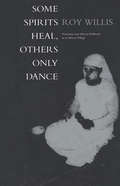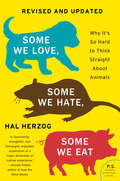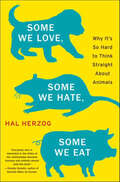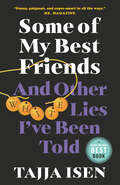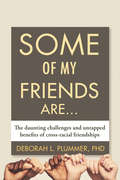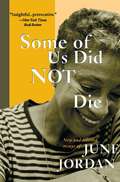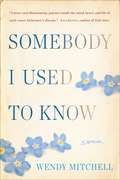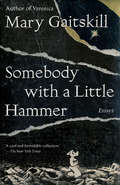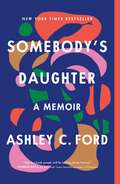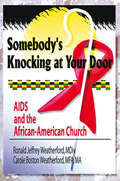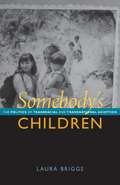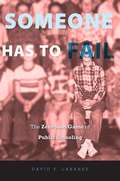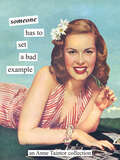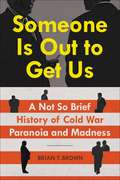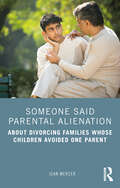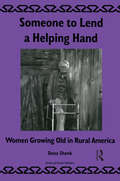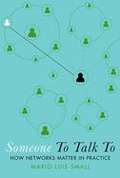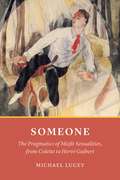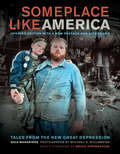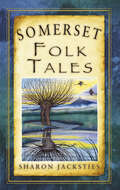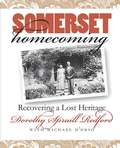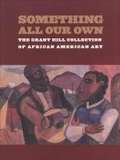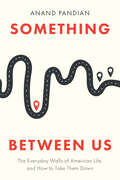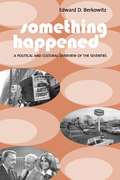- Table View
- List View
Some Spirits Heal, Others Only Dance: A Journey into Human Selfhood in an African Village
by Roy WillisWhere does 'the self' in 'myself' begin and end? And what do ideas of 'spirit' tell us about the nature of human selfhood? To investigate these poorly understood matters, veteran anthropologist, neo-shaman and paranormal healer Roy Willis spent five months in a remote part of northern Zambia exploring human consciousness in a fascinating and sometimes terrifying series of adventures. This absorbing book tells the story of Willis' and his three local colleagues' quest, as they participate in and film rituals of ecstatic union with nature spirits and talk in depth with experts in managing the awesome powers of a world beyond the ordinary. The narrative follows the research team's day-to-day involvement with rituals of spirit revelation, healing, and exorcism, their encounters with the evil powers of sorcery, and the sometimes troubled relations between team members. The African healers in this book emerge both as exceptional individuals and as pioneering explorers of consciousness. Their experience is surprisingly congruent with our present sense of multiple and shifting selfhoods in the age of global electronic communication.
Some We Love, Some We Hate, Some We Eat [Second Edition]: Why It's So Hard to Think Straight About Animals
by Hal HerzogA maverick scientist who co-founded the field of anthrozoology offers a controversial, thought-provoking, and unprecedented exploration of the psychology behind the inconsistent and often paradoxical ways we think, feel, and behave towards animals. How do we reconcile our love for cats and dogs (and rabbits, snakes, hamsters, gerbils, and goldfish) with our appetite for hamburgers and chicken breast and our use of medications that have been tested on lab mice? Why do so many of us—as meat eaters, recreational hunters and fishermen, and visitors of zoos and circuses—take the moral high ground when it comes to condemning activities like cockfighting? And why are dogs considered pets in America but dinner in Korea? With Some We Love, Some We Hate, Some We Eat, Hal Herzog offers a lively and deeply intelligent look inside our complex and often paradoxical relationships with animals. Drawing on over two decades of research in the interdisciplinary field of anthrozoology, the science of human-animal relations, Herzog examines the moral and ethical decisions we all face when it comes to the furry and feathered creatures with whom we share this planet. Alternately poignant and laugh-out-loud funny, Some We Love, Some We Hate, Some We Eat takes readers on a highly entertaining and illuminating journey through the full spectrum of human-animal relations, relating Dr. Herzog’s groundbreaking research on animal rights activists, cockfighters, professional dog show handlers, veterinary students, biomedical researchers, and circus animal trainers. Through psychology, history, biology, sociology, cross-cultural analysis, current animal rights debates, and the morality and ethics surrounding the use and abuse of animals, Herzog carefully crafts a seamless narrative composed of real life anecdotes, academic and scientific research, cross-cultural examples, and his own sense of moral confusion. Combining the intellectual rigor of Michael Pollan’s The Omnivore’s Dilemma with the wry observation of Bill Bryson’s A Walk in the Woods, Herzog offers a refreshing new perspective on our lives with animals—one that will forever change the way we look at our relationships with other creatures and, in so doing, will also change the way we look at ourselves.
Some We Love, Some We Hate, Some We Eat: Why It's So Hard to Think Straight About Animals
by Hal Herzog“Everybody who is interested in the ethics of our relationship between humans and animals should read this book.”—Temple Grandin, author of Animals Make Us HumanHal Herzog, a maverick scientist and leader in the field of anthrozoology offers a controversial, thought-provoking, and unprecedented exploration of the psychology behind the inconsistent and often paradoxical ways we think, feel, and behave towards animals. A cross between Michael Pollan’s The Omnivore’s Dilemma and Bill Bryson’s A Walk in the Woods, Some We Love, Some We Hate, Some We Eat, in the words of Irene M. Pepperberg, bestselling author of Alex & Me, “deftly blends anecdote with scientific research to show how almost any moral or ethical position regarding our relationship with animals can lead to absurd consequences.”
Some of My Best Friends: And other white lies I've been told
by Tajja IsenA fearless and darkly comic essay collection about race, justice and the limits of good intentions from the editor in chief of Catapult.In this stunning debut collection, award-winning voice actor and cultural critic Tajja Isen explores the absurdity of living in a world that has grown fluent in the language of social justice but doesn&’t always follow through. These nine daring essays explore the sometimes troubling and often awkward nature of that discord. Some of My Best Friends takes on subjects including the cartoon industry&’s pivot away from color-blindcasting, the pursuit of diverse representation in the literary world, the law&’s refusal to see inequality, and the cozy fictions of nationalism. Throughout, Isen deftly examines the quick, cosmetic fixes society makes to address systemic problems and reveals the unexpected ways they can misfire. In the spirit of Zadie Smith, Cathy Park Hong and Jia Tolentino, Isen interlaces cultural criticism with her lived experience to explore the gaps between what we say and what we do, what we do and what we value, and what we value and what we demand.
Some of My Friends Are...: The Daunting Challenges and Untapped Benefits of Cross-Racial Friendships
by Deborah PlummerAn insightful look at how cross-racial friendships work and fail within American society.In a U.S. national survey conducted for this book, 70% of respondents strongly agreed that friendships across racial lines are essential to making progress toward improving race relations. However, further polling found that most Americans tend to gravitate towards friendships within their own racial category.Psychologist, Deborah L. Plummer tells us why that is so. She examines how factors such as leisure, politics, humor, faith, social media, and education influence the nature and intensity of cross-racial friendships. With engaging stories and inspiring anecdotes drawn from national focus groups, interviews, and analyses of survey results of contemporary patterns of adult friendships, she provides insights into the fears and discomforts associated with cross-racial friendships. Through these narratives and social analyses of friendship patterns, Plummer explores how we make connections to form solid bonds, and why it is so challenging to do so across a racial divide. She discusses how we cross that divide and get beyond the prickly uncomfortable moments and have meaningful, enlightening, empathetic conversations about race. With the inclusion of personal stories, this book stirs up authentic racial discourse, prompts readers to examine their own friendship patterns, and encourages us all to create a better path toward a more enlightened future by crossing racial lines in friendship and deepening the strength of current cross-racial friends.
Some of Us Did Not Die: New and Selected Essays
by June Jordan"She remains a thinker and activist who 'insists upon complexity. ' "Reamy Jansen, San Francisco Chronicle*Some of Us Did Not Die brings together a rich sampling of the late poet June Jordan's prose writings. The essays in this collection, which include her last writings and span the length of her extraordinary career, reveal Jordan as an incisive analyst of the personal and public costs of remaining committed to the ideal and practice of democracy. Willing to venture into the most painful contradictions of American culture and politics, Jordan comes back with lyrical honesty, wit, and wide-ranging intelligence in these accounts of her reckoning with life as a teacher, poet, activist, and citizen.
Somebody I Used to Know: A Memoir
by Wendy Mitchell“A brave and illuminating journey inside the mind, heart, and life of a person with early-onset Alzheimer’s disease.”—Lisa Genova, author of Still Alice Wendy Mitchell had a busy job with the British National Health Service, raised her two daughters alone, and spent her weekends running and climbing mountains. Then, slowly, a mist settled deep inside the mind she once knew so well, blurring the world around her. She didn’t know it then, but dementia was starting to take hold. In 2014, at age fifty-eight, she was diagnosed with young-onset Alzheimer’s. In this groundbreaking book, Mitchell shares the heartrending story of her cognitive decline and how she has fought to stave it off. What lay ahead of her after the diagnosis was scary and unknowable, but Mitchell was determined and resourceful, and she vowed to outwit the disease for as long as she could. As Mitchell learned to embrace her new life, she began to see her condition as a gift, a chance to experience the world with fresh eyes and to find her own way to make a difference. Even now, her sunny outlook persists: She devotes her time to educating doctors, caregivers, and other people living with dementia, helping to reduce the stigma surrounding this insidious disease. Still living independently, Mitchell now uses Post-it notes and technology to remind her of her routines and has created a “memory room” where she displays photos—with labels—of her daughters, friends, and special places. It is a room where she feels calm and happy, especially on days when the mist descends. A chronicle of one woman’s struggle to make sense of her shifting world and her mortality, Somebody I Used to Know offers a powerful rumination on memory, perception, and the simple pleasure of living in the moment. Philosophical, poetic, intensely personal, and ultimately hopeful, this moving memoir is both a tribute to the woman Wendy Mitchell used to be and a brave affirmation of the woman she has become.Advance praise for Somebody I Used to Know “Somebody I Used to Know is both an indispensable guide for people grappling with the consequences of a dementia diagnosis and a stirring account of courage in the face of devastating loss.”—Booklist (starred review) “This is an eloquent and poignant book. Those of us who have gone on the heartbreaking journey of losing a loved one to dementia have wondered what they were feeling. Wendy Mitchell’s courageous and unflinching account lets us know.”—Patti Davis, author of The Long Goodbye
Somebody with a Little Hammer: Essays
by Mary GaitskillFrom one of the most singular presences in American fiction comes a searingly intelligent book of essays on matters literary, social, cultural, and personal. Whether she’s writing about date rape or political adultery or writers from John Updike to Gillian Flynn, Mary Gaitskill reads her subjects deftly and aphoristically and moves beyond them to locate the deep currents of longing, ambition, perversity, and loneliness in the American unconscious. She shows us the transcendentalism of the Talking Heads, the melancholy of Björk, the playfulness of artist Laurel Nakadate. She celebrates the clownish grandiosity and the poetry of Norman Mailer’s long career and maps the sociosexual cataclysm embodied by porn star Linda Lovelace. And in the deceptively titled “Lost Cat,” she explores how the most intimate relationships may be warped by power and race. Witty, tender, beautiful, and unsettling, Somebody with a Little Hammer displays the same heat-seeking, revelatory understanding for which we value Gaitskill’s fiction.
Somebody's Daughter: A Memoir
by Ashley C. FordOne of the most prominent voices of her generation debuts with an extraordinarily powerful memoir: the story of a childhood defined by the looming absence of her incarcerated father. <P><P>Through poverty, adolescence, and a fraught relationship with her mother, Ashley Ford wishes she could turn to her father for hope and encouragement. There are just a few problems: he’s in prison, and she doesn’t know what he did to end up there. She doesn’t know how to deal with the incessant worries that keep her up at night, or how to handle the changes in her body that draw unwanted attention from men. <P><P>In her search for unconditional love, Ashley begins dating a boy her mother hates. When the relationship turns sour, he assaults her. Still reeling from the rape, which she keeps secret from her family, Ashley desperately searches for meaning in the chaos. <P><P>Then, her grandmother reveals the truth about her father’s incarceration . . . and Ashley’s entire world is turned upside down. Somebody’s Daughter steps into the world of growing up a poor Black girl in Indiana with a family fragmented by incarceration, exploring how isolating and complex such a childhood can be. <P><P>As Ashley battles her body and her environment, she embarks on a powerful journey to find the threads between who she is and what she was born into, and the complicated familial love that often binds them. <P><P><b>A New York Times Bestseller</b>
Somebody's Knocking at Your Door: AIDS and the African-American Church
by Harold G Koenig Carole B Weatherford Ronald J WeatherfordExamining the black church’s response to AIDS, Somebody’s Knocking at Your Door: AIDS and the African-American Church analyzes sexual ethics and homophobia in the black church to provide pastors, social workers, and health professionals with intervention strategies for parishioners or members of the community who have AIDS. By discussing the church’s historic and successful activism and its relationship to the community, along with AIDS statistics, relevant theologies, and other AIDS ministries, this book suggests the benefits of increased church involvement versus other agencies or organizations. Somebody’s Knocking at Your Door will help you develop prevention education and pastoral care programs that will alert individuals to the risks of AIDS and will offer people with AIDS the comfort and assistance they need in coping with the disease.Through the voices of leading clergy, AIDS advocates, and people living with AIDS (PLWAs), this book calls on the African-American church to become more involved in helping communities deal with the disease. Somebody’s Knocking at Your Door offers you ideas on how to improve the lives of individuals with AIDS through the church, including: welcoming PLWAs into the church through announcements by local media, church newsletters, and Sunday bulletins offering AIDS support groups at the church or loaning office space, equipment, or clerical assistance to AIDS organizations recognizing the power of intercessory prayer for PLWAs caring for PLWAs by delivering meals to their homes, preparing meals at the church, and developing a transportation network that will take parishioners to doctor appointments, church, or on recreational outings preparing meals, running errands, housekeeping, handling paperwork, negotiating legal issues, and offering friendship-- possible components of volunteer “buddy programs” for homebound PLWAs training pastors, clergy, and Sunday school teachers to educate ministries on AIDS in the African- American community, sexual intimacy, intravenous drug use and needle sharing, monogamy, community resources, and condom useSince some clergy still believe that AIDS is a “gay” disease, Somebody’s Knocking at Your Door discusses the issue of homosexuality within the church. By analyzing passages from the Bible, the authors refute the belief that homosexuals were neglected by God and undeserving of care and love. This belief, according to the authors, inhibits some churches and individuals from discussing HIV/AIDS because of fear they would also be acknowledging homosexuality. Highlighting AIDS ministries throughout the United States, Somebody’s Knocking at Your Door encourages the African-American church to confront the issue of AIDS and understand that the disease can affect anyone. This book will give you the necessary strategies for starting and implementing AIDS ministries and intervention programs that will educate and support your community.
Somebody’s Children: The Politics of Transnational and Transracial Adoption
by Laura BriggsIn Somebody's Children, Laura Briggs examines the social and cultural forces--poverty, racism, economic inequality, and political violence--that have shaped transracial and transnational adoption in the United States during the second half of the twentieth century and the first decade of the twenty-first. Focusing particularly on the experiences of those who have lost their children to adoption, Briggs analyzes the circumstances under which African American and Native mothers in the United States and indigenous and poor women in Latin America have felt pressed to give up their children for adoption or have lost them involuntarily.The dramatic expansion of transracial and transnational adoption since the 1950s, Briggs argues, was the result of specific and profound political and social changes, including the large-scale removal of Native children from their parents, the condemnation of single African American mothers in the context of the civil rights struggle, and the largely invented "crack babies" scare that inaugurated the dramatic withdrawal of benefits to poor mothers in the United States. In Guatemala, El Salvador, and Argentina, governments disappeared children during the Cold War and then imposed neoliberal economic regimes with U.S. support, making the circulation of children across national borders easy and often profitable. Concluding with an assessment of present-day controversies surrounding gay and lesbian adoptions and the struggles of immigrants fearful of losing their children to foster care, Briggs challenges celebratory or otherwise simplistic accounts of transracial and transnational adoption by revealing some of their unacknowledged causes and costs.
Someone Has To Fail: The Zero-sum Game Of Public Schooling
by David F. Labaree<P>What do we really want from schools?<P> Only everything, in all its contradictions. <P>Most of all, we want access and opportunity for all children—but all possible advantages for our own. <P>So argues historian David Labaree in this provocative look at the way “this archetype of dysfunction works so well at what we want it to do even as it evades what we explicitly ask it to do.”
Someone Has to Set a Bad Example: An Anne Taintor Collection
by Anne TaintorThe phenomenally popular artist wittily reveals the realities behind images of perfect women in midcentury marketing. We can&’t be good all the time, and no one knows it better than Anne Taintor. This generous collection of her most popular artwork includes more than 150 images in categories such as friendship (a real friend will help you hide the body), motherhood (WOW! I get to give birth AND change diapers!), money (screw the budget!), attitude (let a smirk be your umbrella), and more. Also featuring an introduction by Taintor, this hilarious volume perfectly captures the deliciously sarcastic, snarky, and honest things that most women have found themselves thinking at one time or another. If you&’re looking for trouble, look no further. . . .
Someone Is Out to Get Us: A Not So Brief History of Cold War Paranoia and Madness
by Brian BrownFrom UFOs to Dr. Strangelove, LSD experiments to Richard Nixon, author Brian Brown investigates the paranoid, panicked history of the Cold War.In Someone Is Out to Get Us, Brian T. Brown explores the delusions, absurdities, and best-kept secrets of the Cold War, during which the United States fought an enemy of its own making for over forty years -- and nearly scared itself to death in the process. The nation chose to fear a chimera, a rotting communist empire that couldn't even feed itself, only for it to be revealed that what lay behind the Iron Curtain was only a sad Potemkin village.In fact, one of the greatest threats to our national security may have been our closest ally. The most effective spy cell the Soviets ever had was made up of aristocratic Englishmen schooled at Cambridge. Establishing a communist peril but lacking proof, J. Edgar Hoover became our Big Brother, and Joseph McCarthy went hunting for witches. Richard Nixon stepped into the spotlight as an opportunistic, ruthless Cold Warrior; his criminal cover-up during a dark presidency was exposed by a Deep Throat in a parking garage.Someone Is Out to Get Us is the true and complete account of a long-misunderstood period of history during which lies, conspiracies, and paranoia led Americans into a state of madness and misunderstanding, too distracted by fictions to realize that the real enemy was looking back at them in the mirror the whole time. p.p1 {margin: 0.0px 0.0px 0.0px 0.0px; font: 12.0px 'Times New Roman'} p.p2 {margin: 0.0px 0.0px 0.0px 0.0px; font: 12.0px 'Times New Roman'; min-height: 15.0px}
Someone Other Than a Mother: Flipping the Scripts on a Woman's Purpose and Making Meaning beyond Motherhood
by Erin S. LaneTheologian Erin S. Lane overturns dominant narratives about motherhood and inspires women to write their own stories.Is it possible to do something more meaningful than mothering? As a young Catholic girl who grew up in the American Midwest on white bread and Jesus, Erin S. Lane was given two options for a life well-lived: Mother or Mother Superior. She could marry a man and mother her own children, or she could marry God, so to speak, and mother the world&’s children. Both were good outcomes for someone else&’s life. Neither would fit the shape of hers. Interweaving Lane&’s story with those of other women—including singles and couples, stepparents and foster parents, the infertile and the ambivalent—Someone Other Than a Mother challenges the social scripts that put moms on an impossible pedestal and shame childless women and nontraditional families for not measuring up. You may have heard these lines before: • &“Motherhood is the toughest job.&” This script diminishes the work of non-moms and pressures moms to make parenting their full-time gig. • &“It&’ll be different with your own.&” This script underestimates the love of nonbiological kin and pushes unfair expectations onto nuclear families. • &“Family is the greatest legacy.&” This script turns children into the ultimate sign of a woman&’s worth and discounts the quieter ways we leave our mark. With candor and verve, Someone Other Than a Mother tears up the shaming social scripts that are bad for moms and non-moms alike and rewrites the story of a life well-lived, one in which purpose is bigger than body parts, identity is fuller than offspring, and legacy is so much more than DNA.
Someone Said Parental Alienation: About Divorcing Families Whose Children Avoided One Parent
by Jean MercerThis book introduces readers to the concept of parental alienation (PA), a belief system that is used with increasing frequency in judicial child custody and parenting plan decisions.PA is essentially a legal concept without validated psychological definition, assuming that children who resist contact with one divorced parent have in many cases been “brainwashed” or persuaded to do so by the machinations of the preferred parent. PA proponents assert that courts should transfer child custody to the avoided parent and prohibit contact between the child and the preferred parent. Unfortunately, the outcomes of such decisions, as reported by parents and their now-adult children, suggest that application of the PA concept is neither safe nor effective as a response to children’s resistance to contact with a parent. Providing an overview of the concept of parental alienation, methods of identifying PA cases, and court-ordered treatments for children and parents, the book uses seven case-study chapters, each introduced with a brief recapitulation of the issues, and closed with a summary of events to offer suggestions about desirable family court changes.This is the first book to tell a range of stories about the experiences of fathers, mothers, and children who have been separated and subjected to PA interventions after allegations have been made. It will be of interest to professionals practicing in psychology, psychiatry, social work, counselling, law, and the judiciary, and anyone involved in research and in legislative efforts relevant to family courts.
Someone To Lend a Helping Hand: Women Growing Old in Rural America
by D. ShenkBy providing descriptions of the experiences of thirty rural Minnesota women, often in their own words, this timely and topical book examines the expectations, beliefs and values of the women as they grow old in rural America. A lifecourse perspective fosters a better understanding of the aging process in terms of an individual's life experiences within the context of a cultural environment. To show how various elements shaped the women's lives in later years, and to give the fullest possible descriptions, the study combines both qualitative and quantitative research of the rural elderly in Minnesota. Through their stories, the women stress the cultural, familial and personal issues that continue to be important to them as they age. They explore the elements of continuity, as well as those of change, as a part of the lifecourse. Also detailed are their insights and experiences concerning interactions with different formal and informal support networks, as well as the more general topics.
Someone To Talk To: How Networks Matter In Practice
by Mario Luis SmallWhen people are facing difficulties, they often feel the need for a confidant. How do they decide on whom to rely? In Someone To Talk To, Mario Luis Small follows a group of graduate students as they cope with stress, overwork, self-doubt, failure, relationships, children, health care, and poverty. He unravels how they decide whom to turn to for support. And he then confirms his findings based on representative national data on adult Americans. Small shows that rather than consistently relying on their "strong ties," Americans often take pains to avoid close friends and family, as these relationships are both complex and fraught with expectations. In contrast, they often confide in "weak ties," as the need for understanding or empathy trumps their fear of misplaced trust. In fact, people may find themselves confiding in acquaintances and even strangers unexpectedly, without having reflected on the consequences. Amid a growing wave of big data and large-scale network analysis, Small returns to the basic questions of whom we connect with, how, and why, upending decades of conventional wisdom on how we should think about and analyze social networks.
Someone: The Pragmatics of Misfit Sexualities, from Colette to Hervé Guibert
by Michael LuceyImagine trying to tell someone something about yourself and your desires for which there are no words. What if the mere attempt at expression was bound to misfire, to efface the truth of that ineluctable something? In Someone, Michael Lucey considers characters from twentieth-century French literary texts whose sexual forms prove difficult to conceptualize or represent. The characters expressing these “misfit” sexualities gravitate towards same-sex encounters. Yet they differ in subtle but crucial ways from mainstream gay or lesbian identities—whether because of a discordance between gender identity and sexuality, practices specific to a certain place and time, or the fleetingness or non-exclusivity of desire. Investigating works by Simone de Beauvoir, Colette, Jean Genet, and others, Lucey probes both the range of same-sex sexual forms in twentieth-century France and the innovative literary language authors have used to explore these evanescent forms. As a portrait of fragile sexualities that involve awkward and delicate maneuvers and modes of articulation, Someone reveals just how messy the ways in which we experience and perceive sexuality remain, even to ourselves.
Someplace Like America
by Dale Maharidge Michael S. Williamson Bruce SpringsteenIn Someplace Like America, writer Dale Maharidge and photographer Michael S. Williamson take us to the working-class heart of America, bringing to life--through shoe leather reporting, memoir, vivid stories, stunning photographs, and thoughtful analysis--the deepening crises of poverty and homelessness. The story begins in 1980, when the authors joined forces to cover the America being ignored by the mainstream media--people living on the margins and losing their jobs as a result of deindustrialization. Since then, Maharidge and Williamson have traveled more than half a million miles to investigate the state of the working class (winning a Pulitzer Prize in the process). In Someplace Like America, they follow the lives of several families over the thirty-year span to present an intimate and devastating portrait of workers going jobless. This brilliant and essential study--begun in the trickle-down Reagan years and culminating with the recent banking catastrophe--puts a human face on today's grim economic numbers. It also illuminates the courage and resolve with which the next generation faces the future.
Somerset Folk Tales (Folk Tales: United Kingdom)
by Sharon JackstiesThese Somerset tales, newly collected or retold with a strong sense of the land and the waters that shaped them, reflect our enduring interest in the natural landscape. Let these stories from the Summer Lands take you on a journey: across wind-wild moors that plummet to treacherous tides traversed by sea morgans; on a scramble from gorges shaped by the Devil’s spite to caves dwelled in by bitter witches. Discover ancient mines and dragons’ haunts, and emerge into forests and fields to be befriended by bees or bedevilled by fairies; then stroll beside ancient waterways, where willows walk and orchards talk. From Gwyn ap Neath to Joseph of Arimathea, your travelling companions will meet you from legend, history and living memory – from the places where they were once known best. Sharon Jacksties has a sharp eye for the landscape of Somerset and the seen and unseen stories that it holds, a sympathetic ear for the dialect of the South West, and a playful wit that brings this collection of tales to vivid and delightful life.
Somerset Homecoming
by Dorothy Spruill RedfordIn 1860, Somerset Place was one of the most successful plantations in North Carolina--and its owner one of the largest slaveholders in the state. More than 300 slaves worked the plantation's fields at the height of its prosperity; but nearly 125 years later, the only remembrance of their lives at Somerset, now a state historic site, was a lonely wooden sign marked "Site of Slave Quarters."Somerset Homecoming, first published in 1989, is the story of one woman's unflagging efforts to recover the history of her ancestors, slaves who had lived and worked at Somerset Place. Traveling down winding southern roads, through county courthouses and state archives, and onto the front porches of people willing to share tales handed down through generations, Dorothy Spruill Redford spent ten years tracing the lives of Somerset's slaves and their descendants. Her endeavors culminated in the joyous, nationally publicized homecoming she organized that brought together more than 2,000 descendants of the plantation's slaves and owners and marked the beginning of a campaign to turn Somerset Place into a remarkable resource for learning about the history of both African Americans and whites in the region.
Something All Our Own: The Grant Hill Collection of African American Art
by Grant Hill Alvia WardlawSince 1990, Grant Hill has thrilled sports fans with his artistry on the basketball court, first as an All-American player at Duke University and then as a six-time NBA All-Star for the Detroit Pistons and the Orlando Magic. During these years, Hill has amassed a collection of art by African Americans that he now shares with the public through this book, which accompanies a traveling exhibition. The forty-six pieces documented here include thirteen works that span the career of the great Romare Bearden, from his 1941 gouache painting Serenade to the important collages of the 1980s. Hill's fascination with artists' depiction of women is represented in Elizabeth Catlett's lithographs, many of them from the 1992 series "For My People," and her sculptures in stone, bronze, and onyx. In addition to these two giants of twentieth-century art, the Hill Collection features pieces by Phoebe Beasley, Arthello Beck Jr., John Biggers, Malcolm Brown, John Coleman, Edward Jackson, and Hughie Lee Smith. Hill began collecting art in the early 1990s after learning from his parents to appreciate artworks not only as objects of beauty but as expressions of heritage and culture. According to the internationally known curator Alvia J. Wardlaw, he is part of an emerging group of young African American collectors who have "raised the bar for others." Hill writes, "Getting to know yourself means understanding your background and appreciating those who have come before you. My father has a saying he uses in speeches: 'To be ignorant of your past is to remain a boy. 'The interest in my heritage as an African American is reflected in this collection." Something All Our Own features Wardlaw's essay on the history of African American collecting. It also features articles about Bearden and Catlett by the scholars Elizabeth Alexander and Beverly Guy-Sheftall and reflections about Hill by the historian John Hope Franklin, Duke's basketball coach Mike Krzyzewski, and the sportswriter William C. Rhoden. Hill and his father, the NFL great Calvin Hill, contribute a dialogue that explores their motivations for collecting art. At the heart of the book are the exquisite color photographs of the forty-six artworks included in the exhibition, with commentary by Wardlaw and by Hill himself. As a star athlete, Grant Hill is well aware that African Americans who excel in sports and entertainment are more broadly recognized than their counterparts in artistic fields. He strives to inspire young people to explore their heritage and broaden their concept of excellence by learning more about African American art. By sharing his artworks with collectors and fans, Hill reminds us that while the jump shot is ephemeral, art is enduring.
Something Between Us: The Everyday Walls of American Life, and How to Take Them Down
by Anand PandianAn anthropologist's quest to understand the deep social and political divides in American society, and the everyday strategies that can overcome them. In 2016, Anand Pandian was alarmed by Donald Trump's harsh attacks on immigrants to the United States, the appeal of that politics of anger and fear. In the years that followed, he crisscrossed the country—from Fargo, North Dakota to Denton, Texas, from southern California to upstate New York—seeking out fellow Americans with markedly different social and political commitments, trying to understand the forces that have hardened our suspicions of others. The result is Something Between Us: The Everyday Walls of American Life, and How to Take Them Down, a groundbreaking and ultimately hopeful exploration of the ruptures in our social fabric, and courageous efforts to rebuild a collective life beyond them. The stakes of disconnection have never been higher. From the plight of migrants and refugees to the climate crisis and the recent pandemic, so much turns on the care and concern we can muster for lives and circumstances beyond our own. But as Pandian discovers, such empathy is often thwarted by the infrastructure of everyday American life: fortified homes and neighborhoods, bulked-up cars and trucks, visions of the body as an armored fortress, and media that shut out contrary views. Home and road, body and mind: these interlocking walls sharpen the divide between insiders and outsiders, making it difficult to take unfamiliar people and perspectives seriously, to acknowledge the needs of others and relate to their struggles. Through vivid encounters with Americans of many kinds—including salesmen, truck drivers, police officers, urban planners, and activists for women's rights and environmental justice—Pandian shares tools to think beyond the twists and turns of our bracing present. While our impasses draw from deep American histories of isolation and segregation, he reveals how strategies of mutual aid and communal caretaking can help to surface more radical visions for a life in common with others, ways of meeting strangers in this land as potential kin.
Something Happened: A Political and Cultural Overview of the Seventies
by Edward BerkowitzIn both the literal and metaphorical senses, it seemed as if 1970s America was running out of gas. The decade not only witnessed long lines at gas stations but a citizenry that had grown weary and disillusioned. High unemployment, runaway inflation, and the energy crisis, caused in part by U.S. dependence on Arab oil, characterized an increasingly bleak economic situation. As Edward D. Berkowitz demonstrates, the end of the postwar economic boom, Watergate, and defeat in Vietnam led to an unraveling of the national consensus. During the decade, ideas about the United States, how it should be governed, and how its economy should be managed changed dramatically. Berkowitz argues that the postwar faith in sweeping social programs and a global U.S. mission was replaced by a more skeptical attitude about government's ability to positively affect society.From Woody Allen to Watergate, from the decline of the steel industry to the rise of Bill Gates, and from Saturday Night Fever to the Sunday morning fervor of evangelical preachers, Berkowitz captures the history, tone, and spirit of the seventies. He explores the decade's major political events and movements, including the rise and fall of détente, congressional reform, changes in healthcare policies, and the hostage crisis in Iran. The seventies also gave birth to several social movements and the "rights revolution," in which women, gays and lesbians, and people with disabilities all successfully fought for greater legal and social recognition. At the same time, reaction to these social movements as well as the issue of abortion introduced a new facet into American political life-the rise of powerful, politically conservative religious organizations and activists.Berkowitz also considers important shifts in American popular culture, recounting the creative renaissance in American film as well as the birth of the Hollywood blockbuster. He discusses how television programs such as All in the Family and Charlie's Angels offered Americans both a reflection of and an escape from the problems gripping the country.
